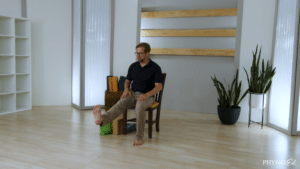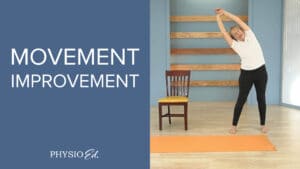Dementia poses unique challenges for those diagnosed and their loved ones, but hope exists beyond a dementia diagnosis.
Though memory lapses and behavioral changes can be challenging at any level, there are actions you can take to combat some of the most difficult symptoms of this all-too-common disease.
Physical therapy can help dementia patients improve their physical and mental health, maintain their functional abilities, manage their behavioral and psychological symptoms, and enhance their well-being. This article will delve into many benefits of physical therapy and exercise for dementia patients.
An Overview of the Benefits
Physical therapy offers a beacon of hope for individuals with dementia, providing a comprehensive approach to improving both physical and cognitive health.
As we delve into the benefits of physical therapy, we’ll explore how targeted exercises and therapeutic strategies can enhance cognitive function, foster independence, and manage the often challenging behavioral and psychological symptoms associated with dementia.
From promoting mental agility to improving daily functional abilities, physical therapy stands as a crucial ally in the journey of dementia care.
This article aims to illuminate the multifaceted role of physical therapy in supporting individuals with dementia, offering practical solutions and hope for patients and their caregivers alike.
Enhancing Cognitive Function

Physical therapy is crucial in improving cognitive abilities in individuals with dementia.
Regular physical activity has been shown to positively impact the brain, promoting mental resilience and neuroplasticity, or the ability to change and adapt to new experiences and challenges. Physical activity can also increase blood flow and oxygen delivery to the brain, supporting health and function.
Specific exercises and techniques used in physical therapy for cognitive enhancement involve multisensory activities, coordination exercises, and problem-solving tasks. Some examples of this include1:
Memory exercises
Information recall, such as names, dates, places, or events, specifically after a delay or with distractions. These can strengthen the ability to store and retrieve information.
An example of a memory exercise I often use with my patients is saying five unrelated words out loud in a slow, steady tone of voice. I then ask the patient to repeat these words immediately to test short-term memory.
After 20-30 minutes, during which the patient performs other exercises while I engage them by asking thought-provoking questions, I ask them to repeat the exact words again.
Attention exercises
Focusing on a specific task or stimulus while ignoring irrelevant ones can help improve concentration, alertness, and processing speed.
An exercise focusing on dividing attention may include navigation tasks involving walking while consulting a map. Looking between the map and your environment while trying to find your way to a destination challenges your alternating attention skills.
Reasoning exercises
These exercises involve making decisions or drawing conclusions based on given information to help improve logical thinking, planning, and judgment. Pattern recognition is an excellent example of a reasoning exercise we frequently use with patients.
This can be as simple as identifying patterns in a series of drawings:
- Prompt the patient with this pattern: circle, diamond, [BLANK], triangle, circle, [BLANK], square, triangle
- Ask the patient to fill in the blanks to complete the pattern. This can be completed as a visual exercise with actual shapes or a written exercise using the words listed in the above sequence.
Problem-solving exercises
These exercises aim to improve executive functions, such as goal-setting, organization, and multitasking. They involve finding solutions to practical or hypothetical situations that require creativity, flexibility, or adaptation.
An example includes having a patient create a grocery list based on a familiar recipe. The PT will provide a list of items and prices from which the patient can choose.
This alone may be difficult, but for a further challenge, you can give the patient a budget for shopping to stay within or ask them to total up the cost and provide change based on a $50 or $100 bill.
Activities like these stimulate the brain and promote the formation of new neural connections. I also find benefits in incorporating enjoyable activities like music and dance, which further engage cognitive functions and enhance overall well-being.
It can be challenging to get buy-in from older adults with dementia to perform some exercises since they may have difficulty understanding the purpose. They may be more likely to participate and benefit from the therapy by making activities fun or physically engaging.
Promoting Independence and Functional Abilities

Maintaining mobility and preventing physical decline are central goals for dementia patients in physical therapy.
Physical therapists employ strategies to preserve a patient’s range of motion and flexibility and exercises to counter muscle weakness and joint stiffness. By addressing these physical challenges, individuals with dementia can maintain their independence and functional abilities for longer.
Balance & Activities of Daily Living
Another crucial focus of physical therapy is enhancing balance and reducing the risk of falls. Falls are a common cause of injury and disability among older adults, especially those with dementia.
Reducing fall risk by addressing factors such as forward-leaning posture, coordination, vision, and sensory input can improve safety and quality of life.
Balance training exercises and proprioceptive activities help improve stability and reduce the likelihood of accidents.
I will also often suggest environmental modifications to promote safety in my patient’s environment. These include using nightlights, removing throw rugs, and keeping the walkways and highly trafficked rooms clutter-free.
Physical therapy is instrumental in improving activities of daily living (ADLs) and functional independence. ADLs can include dressing, grooming, bathing, toileting, feeding, and transferring. These tasks can be extra challenging due to cognitive impairment, memory loss, or behavioral changes.
Physical therapists can use various strategies to help dementia patients perform these tasks, such as simplifying instructions, providing cues and prompts, modifying the environment, and using adaptive equipment.
Through adaptive techniques and the use of assistive devices, PT can help individuals with dementia regain or maintain their ability to perform their self-care tasks.2
The Importance of Walking
Walking is a fundamental skill that enables dementia patients to participate in social and recreational activities, maintain their health and well-being, and preserve their dignity and autonomy.
Gait training and ambulation support are essential components of a dementia patient’s PT program. Physical therapists address gait disturbances and postural abnormalities by implementing walking aids—such as walkers or canes—and teaching proper gait mechanics, with or without an assistive device.
Managing Behavioral and Psychological Symptoms

Dementia patients often experience behavioral and psychological symptoms like anxiety, depression, agitation, aggression, and mood swings. These symptoms can affect their emotional well-being, interpersonal relationships, and quality of life.
Although it might seem unrelated, physical therapy can also help manage these behavioral changes.
PT Strategies for Mood Regulation
Exercise is a natural mood booster and stress reducer, alleviating anxiety and depression by increasing endorphins and other natural brain chemicals that regulate mood and stress.
Physical therapists incorporate relaxation techniques and breathing exercises, helping individuals with dementia achieve calm and emotional well-being and positive reinforcement.
Structured physical activities play a crucial role in reducing agitation and aggression. By providing individuals with dementia with structured routines and purposeful physical tasks, restless energy can be redirected positively and meaningfully. Creating calming and predictable environments further helps manage behavioral symptoms and promote security.
Engaging in regular physical activity has a profound impact on overall mood and well-being. Encouraging social interaction and group activities within the physical therapy setting fosters a sense of community and combats social isolation.
Additionally, incorporating enjoyable exercises that align with individual interests and preferences promotes positive emotions and enhances overall well-being.1
Common Modes of Exercise for Dementia Patients in Physical Therapy
Aerobic exercises
These include activities that increase the heart rate and breathing, such as walking, cycling, swimming, or dancing. They improve cardiovascular health, oxygen delivery to the brain, and mood.
Resistance exercises
This variety of exercises involve activities that strengthen the muscles and bones, such as lifting weights, using elastic bands, or doing push-ups to improve posture, balance, mobility, and self-esteem
Stretching exercises
Stretching improves flexibility and range of motion of the joints and muscles to relieve tension, pain, stiffness, and stress. Examples include yoga, tai chi, and pilates.
Sensory Integration Therapy
SIT is used to improve responses to sensory input that may be restrictive or overwhelming, sensory integration therapy can help reduce sensory overload, confusion, irritability, and agitation.
Relaxation Techniques
These can help lower blood pressure, heart rate, and cortisol levels (a hormone associated with stress) and increase feelings of peace and comfort. These involve activities that help calm the mind and body, such as breathing exercises, meditation, guided imagery, or progressive muscle relaxation.
Cognitive-Behavioral Therapy (CBT)
This psychotherapy-based treatment helps identify and change negative thoughts and behaviors contributing to emotional distress. CBT improves coping and problem-solving skills, self-awareness, and self-control.
Improving Quality of Life

Social isolation, loneliness, and boredom are common challenges for dementia patients. By enhancing their social interaction, self-esteem, purpose, and engagement, physical therapy improves the quality of life for individuals with dementia.
It can enhance social interaction to reduce social isolation by providing opportunities to interact with others through supportive and stimulating environments, group therapy sessions, and community-based programs.
Physical therapists can also boost self-esteem and confidence by helping patients achieve their goals, overcome challenges, and improve their abilities. This may help them feel more valued, respected, and empowered.
Fostering a sense of purpose and engagement through meaningful and enjoyable activities can help those with dementia feel more fulfilled, motivated, and happy. It’s best to tailor exercises to the patient’s interests, hobbies, and abilities to promote their enjoyment of participation.3
Reducing caregiver burden and stress is an often overlooked aspect of physical therapy treatment for dementia patients. Caregivers are often overwhelmed with the demands of caring for someone with dementia.
Physical therapists educate caregivers on safe techniques and proper body mechanics to minimize the risk of injury. Support groups and respite care options are also available, providing caregivers with the support they need to maintain their own well-being.
Addressing Comorbidities and Health Conditions

Dementia patients often have other health conditions or comorbidities that can affect their physical and mental health. Physical therapy can help address these associated comorbidities and improve patients’ overall health outcomes. Some of the focus areas to manage common health conditions include:
- General pain and discomfort management: Using modalities (heat, cold, electrical stimulation, massage) and exercise prescription to improve mobility and function, physical therapy can help manage pain and discomfort caused by arthritis, neuropathy, muscle spasms, or other sources.
- Cardiovascular health and circulation improvement: Increasing the heart rate and blood flow through aerobic exercises can help lower blood pressure, cholesterol, and risk of heart disease or stroke. Physical therapists can monitor the vital signs and symptoms of dementia patients during exercise to ensure safety and prevent complications.
- Improved respiratory function: Physical therapy can help improve respiratory function by strengthening the respiratory muscles, improving posture, and enhancing lung capacity. Breathing exercises and techniques can also help dementia patients cope with shortness of breath, coughing, or wheezing caused by chronic obstructive pulmonary disease (COPD) or asthma.
- Prevention of muscle weakness and joint stiffness: By maintaining or increasing muscle mass, tone, and strength through resistance exercises, PT can improve joint range of motion and flexibility through stretching exercises. This can help prevent contractures, deformities, or pressure ulcers affecting the skin and soft tissues.
Collaborative Approach and Individualized Treatment Plans

A collaborative approach is essential in managing dementia, and physical therapists play a vital role on a care team. By coordinating with physicians, psychologists, and occupational therapists, physical therapists ensure comprehensive and holistic care for individuals with dementia.
Collaboration between physical therapists, caregivers, and healthcare professionals is vital for successful dementia management. Sharing knowledge, progress, and concerns among the team leads to a more comprehensive and integrated approach to care. Building a support network for the patient and their loved ones helps alleviate the challenges associated with dementia.3
Physical therapy for dementia patients is most effective based on individualized treatment plans tailored to each patient’s needs, preferences, and abilities. Regular assessments ensure treatment plans are adapted to accommodate changing needs and goals, ensuring they remain realistic and achievable.
By tailoring interventions to the individual, physical therapy maximizes the benefits and outcomes for people with dementia.
Key Takeaways
- Physical therapy can greatly improve the quality of life for individuals with dementia by helping them maintain independence and engage in meaningful activities.
- Through various exercises and activities, physical therapy can help enhance cognitive function, manage behavioral symptoms, and address other health issues that may coexist with dementia.
- Physical therapists use a collaborative approach, working with caregivers and other healthcare professionals to ensure that dementia patients receive comprehensive, individualized care.
- By embracing the power of physical therapy, individuals with dementia can experience improved cognitive function, enhanced mobility, and overall increased well-being.
- The goal of physical therapy in dementia care is not only to manage the symptoms of the disease but also to unlock the potential for a brighter and more fulfilling future for those living with this condition.
FAQs
What physical therapy exercises are best for improving cognitive abilities in dementia patients?
Specific exercises may vary based on a patient’s condition and abilities. For this reason, physical therapy often utilizes multisensory activities, coordination exercises, and problem-solving tasks. Memory recall activities, attention-dividing tasks, reasoning exercises, and practical problem-solving scenarios are tailored to enhance cognitive function and promote neuroplasticity.
How does physical therapy for dementia patients address fall prevention and safety in the home?
Physical therapy focuses heavily on enhancing balance and reducing the risk of falls in older adults with dementia. Through balance training exercises and proprioceptive activities, stability can be improved. PTs might suggest modifications in the patient’s environment. Using nightlights, removing throw rugs, and decluttering rooms to further enhance safety at home can help.
How does physical therapy integrate into a comprehensive treatment plan for a patient with dementia?
Physical therapy is a critical component of a collaborative approach to managing dementia. Physical therapists can ensure comprehensive and holistic care by coordinating with physicians, psychologists, and occupational therapists. This multidisciplinary approach allows knowledge, progress, and concerns to be shared among the team, leading to a more integrated and effective treatment plan.
How can physical therapy help alleviate the burden of caregiving for dementia patients?
Physical therapists can educate caregivers on safe techniques and proper body mechanics to minimize the risk of injury when assisting dementia patients. They can also provide resources on support groups and respite care options, offering caregivers much-needed support while caring for their loved ones. This form of education and support can contribute significantly to reducing caregiver stress and burnout.
How can physical therapy be tailored to individual dementia patients for maximum effectiveness?
To maximize benefits, physical therapy should be tailored to each dementia patient’s needs, preferences, and abilities. Regular assessments ensure treatment plans can be adapted to accommodate changing needs and goals, keeping them realistic and achievable. By personalizing interventions, physical therapy can offer optimized outcomes for people with dementia.
How does physical therapy contribute to the social well-being of dementia patients?
Physical therapy can offer significant social benefits for dementia patients. By providing opportunities to interact with others through group therapy sessions and community-based programs, therapists can reduce feelings of social isolation. Moreover, therapists often incorporate exercises that align with individual interests and preferences, fostering a sense of community and engagement.
Resources:
- S. L. da Silva Rodrigues et al., “Physical exercise as a non-pharmacological strategy for reducing behavioral and psychological symptoms in elderly with mild cognitive impairment and dementia: a systematic review of randomized clinical trials,” Arq Neuropsiquiatr., vol. 79, no. 12, pp. 1129-1137, Dec. 2021, doi: 10.1590/0004-282X-ANP-2020-0539 [Online]. Available: https://pubmed.ncbi.nlm.nih.gov/34877985/.
- A. De la Rosa et al., “Physical exercise in the prevention and treatment of Alzheimer’s disease,” J Sport Health Sci., vol. 9, no. 5, pp. 394-404, Sep. 2020, doi: 10.1016/j.jshs.2020.01.004 [Online]. Available: https://pubmed.ncbi.nlm.nih.gov/32780691/.
- “Effectiveness of physiotherapy in elderly patients with dementia,” [Online]. Available: https://pubmed.ncbi.nlm.nih.gov/29189083/.







